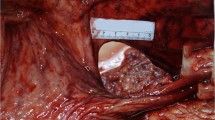Abstract
Gastromalacia is a postmortem artifact resulting from autolysis of the gastric walls. Gastromalacia is autolytic rupture of the stomach caused by endogenous enzymes, and it is devoid of any vital reactions. The left leaf of the diaphragm is occasionally perforated by a ragged fenestration, with escape of gastric contents into the pleural cavity. This rupture may lead to pneumoperitoneum or pneumothorax. For diagnostic radiologists, gastromalacia is rarely encountered. Therefore, they should be aware of this entity to avoid misdiagnosis when performing postmortem radiography.





Similar content being viewed by others
References
Hunter J. On the digestion of the stomach after death. Philos Trans R Soc London. 1772;62:447–52.
Joshua AP. Time of death and changes after death. In: Spitz WU, editor. Medico-legal investigation of death: guidelines for the application of pathology to crime investigation. 4th ed. Springfield: Charles C Thomas; 2006. p. 14–49.
Laczniak AN, Sato Y, Nashelsky M. Postmortem gastric perforation (gastromalacia) mimicking abusive injury in sudden unexplained infant death. Pediatr Radiol. 2011;41:1595–7.
O’Donnell CJ, Baker MA. Postmortem CT findings of gastromalacia: a trap for the radiologist with forensic interest. Forensic Sci Med Pathol. 2010;6:293–7.
Fischer F, Grimm J, Kirchhoff C, Reiser MF, Graw M, Kirchhoff S. Postmortem 24-h interval computed tomography findings on intrahepatic gas development and changes of liver parenchyma radiopacity. Forensic Sci Int. 2012;214:118–23.
Kanetake J, Kanawaku Y, Funayama M. Automatic continuous monitoring of rectal temperature using a button-type thermo data logger. Leg Med (Tokyo). 2006;8:226–30.
Molina DK. Handbook of forensic toxicology for medical examiners. Boca Raton: CRC press; 2010.
Brown TH, Davidson PF, Larson GM. Acute gastritis occurring within 24 h of severe head injury. Gastrointest Endosc. 1989;35:37–40.
Larson GM, Koch S, O’Dorisio TM, Osadchey B, McGraw P, Richardson JD. Gastric response to severe head injury. Am J Surg. 1984;147:97–105.
Kawasumi Y, Usui A, Hosokai Y, Sato M, Funayama M. Heat haematoma: post-mortem computed tomography findings. Clin Radiol. 2013;68:e95–7.
Acknowledgments
The authors thank Aya Nakajima and Kenta Abiko for their excellent help in data acquisition during the radiological examinations and forensic autopsies.
We have no relevant financial interests or personal affiliations in connection with the content of this manuscript.
Author information
Authors and Affiliations
Corresponding author
About this article
Cite this article
Usui, A., Kawasumi, Y., Hosokai, Y. et al. Postmortem radiography of gastromalacia: case reports. Jpn J Radiol 31, 637–641 (2013). https://doi.org/10.1007/s11604-013-0229-1
Received:
Accepted:
Published:
Issue Date:
DOI: https://doi.org/10.1007/s11604-013-0229-1




